automatic transmission INFINITI QX70 2014 Owner's Guide
[x] Cancel search | Manufacturer: INFINITI, Model Year: 2014, Model line: QX70, Model: INFINITI QX70 2014Pages: 530, PDF Size: 2.48 MB
Page 444 of 530

8 Maintenance and do-it-yourself
Maintenance requirement .................................... 8-2Scheduled maintenance .................................. 8-2
General maintenance....................................... 8-2
Where to go for service ................................... 8-2
General maintenance ........................................... 8-2 Explanation of maintenance items ................... 8-2
Maintenance precautions ..................................... 8-5
Engine compartment check locations ................... 8-7 VQ37VHR engine ............................................. 8-7
VK50VE engine ................................................ 8-8
Engine cooling system ......................................... 8-9 Checking engine coolant level ....................... 8-10
Changing engine coolant ............................... 8-11
Engine oil .......................................................... 8-11 Checking engine oil level............................... 8-12
Changing engine oil and filter ....................... 8-12
Automatic transmission fluid ............................. 8-15
Power steering fluid........................................... 8-15
Brake fluid......................................................... 8-16 Brake fluid .................................................... 8-16
Window washer fluid ......................................... 8-16
Battery .............................................................. 8-17 Jump starting ................................................ 8-19
Variable voltage control system ......................... 8-19 Drive Belts ........................................................ 8-19
Spark plugs ...................................................... 8-20 Replacing spark plugs ................................. 8-21
Air cleaner ........................................................ 8-21
Windshield wiper blades ................................... 8-22 Cleaning ...................................................... 8-22
Replacing..................................................... 8-23
Rear window wiper blades ................................ 8-24
Brakes .............................................................. 8-24 Self-adjusting brakes ................................... 8-24
Brake pad wear warning .............................. 8-24
Fuses ................................................................ 8-25 Engine compartment .................................... 8-25
Passenger compartment............................... 8-26
Intelligent Key battery replacement ................... 8-27
Lights................................................................ 8-29
Headlights ................................................... 8-30
Exterior and interior lights ........................... 8-30
Wheels and tires ............................................... 8-32 Tire pressure ............................................... 8-32
Tire labeling ................................................ 8-36
Types of tires............................................... 8-38
Tire chains ................................................... 8-39
Changing wheels and tires........................... 8-39
Page 446 of 530

is released.
When driving in areas using road salt or
other corrosive materials, check lubrication
frequently.
Lights*:Clean the headlights on a regular
basis. Make sure that the headlights, stop
lights, tail lights, turn signal lights, and
other lights are all operating properly and
installed securely. Also check headlight
aim.
Road wheel nuts (lug nuts)*: When check-
ing the tires, make sure no wheel nuts are
missing, and check for any loose wheel
nuts. Tighten if necessary.
Tire rotation*: Tires should be rotated
every 5,000 miles (8,000 km).
Tires*: Check the pressure with a gauge
often and always prior to long distance
trips. If necessary, adjust the pressure in
all tires, including the spare, to the
pressure specified. Check carefully for
damage, cuts or excessive wear.
Tire Pressure Monitoring System (TPMS)
transmitter components: Replace the TPMS
transmitter grommet seal, valve core and
cap when the tires are replaced due to
wear or age.
Tire, wheel alignment and balance: If thevehicle should pull to either side while
driving on a straight and level road, or if
you detect uneven or abnormal tire wear,
there may be a need for wheel alignment.
If the steering wheel or seat vibrates at
normal highway speeds, wheel balancing
may be needed.
For additional information regarding tires,
refer to
“Important Tire Safety Information”
(US) or “Tire Safety Information” (Canada)
in the INFINITI Warranty Information Book-
let.
Windshield: Clean the windshield on a
regular basis. Check the windshield at
least every six months for cracks or other
damage. Have a damaged windshield
repaired by a qualified repair facility.
Windshield wiper blades*: Check for
cracks or wear if they do not wipe properly.
Inside the vehicle
The maintenance items listed here should
be checked on a regular basis, such as
when performing periodic maintenance,
cleaning the vehicle, etc.
Accelerator pedal: Check the pedal for
smooth operation and make sure the pedal
does not catch or require uneven effort. Keep the floor mat away from the pedal.
Automatic transmission P (Park) mechan-
ism:
On a fairly steep hill, check that your
vehicle is held securely with the shift lever
in the P (Park) position without applying
any brakes.
Brake pedal: Check the pedal for smooth
operation. If the brake pedal suddenly
goes down further than normal, the pedal
feels spongy or the vehicle seems to take
longer to stop, see an INFINITI retailer
immediately. Keep the floor mat away from
the pedal.
Brakes: Check that the brakes do not pull
the vehicle to one side when applied.
Parking brake: Check the parking brake
operation regularly. The vehicle should be
securely held on a fairly steep hill with only
the parking brake applied. If the parking
brake needs adjusted, see an INFINITI
retailer.
Seat belts: Check that all parts of the seat
belt system (for example, buckles, an-
chors, adjuster and retractors) operate
properly and smoothly, and are installed
securely. Check the belt webbing for cuts,
fraying, wear or damage.
Seats: Check seat position controls such as
Maintenance and do-it-yourself8-3
Page 448 of 530
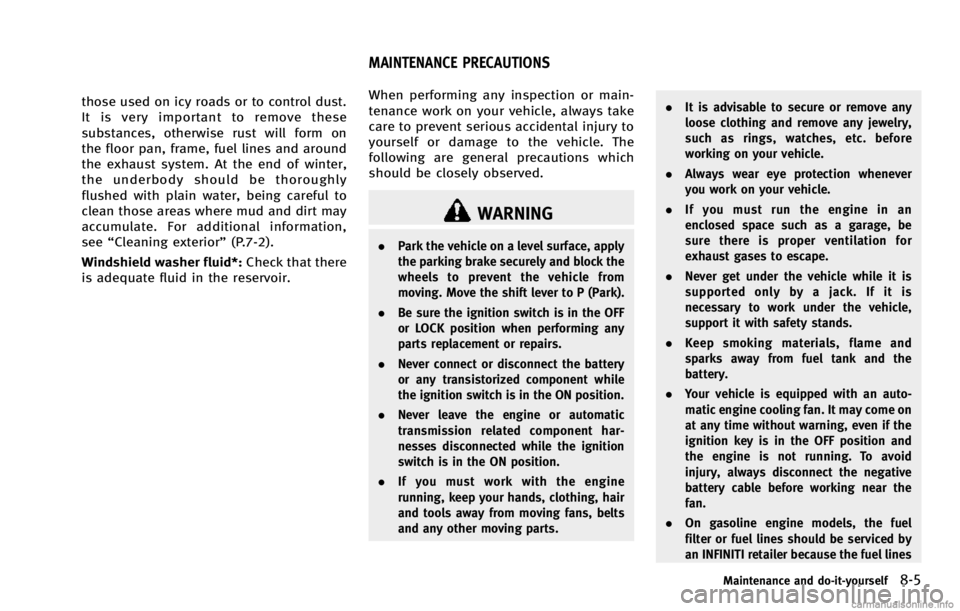
those used on icy roads or to control dust.
It is very important to remove these
substances, otherwise rust will form on
the floor pan, frame, fuel lines and around
the exhaust system. At the end of winter,
the underbody should be thoroughly
flushed with plain water, being careful to
clean those areas where mud and dirt may
accumulate. For additional information,
see“Cleaning exterior” (P.7-2).
Windshield washer fluid*: Check that there
is adequate fluid in the reservoir. When performing any inspection or main-
tenance work on your vehicle, always take
care to prevent serious accidental injury to
yourself or damage to the vehicle. The
following are general precautions which
should be closely observed.
WARNING
.
Park the vehicle on a level surface, apply
the parking brake securely and block the
wheels to prevent the vehicle from
moving. Move the shift lever to P (Park).
. Be sure the ignition switch is in the OFF
or LOCK position when performing any
parts replacement or repairs.
. Never connect or disconnect the battery
or any transistorized component while
the ignition switch is in the ON position.
. Never leave the engine or automatic
transmission related component har-
nesses disconnected while the ignition
switch is in the ON position.
. If you must work with the engine
running, keep your hands, clothing, hair
and tools away from moving fans, belts
and any other moving parts. .
It is advisable to secure or remove any
loose clothing and remove any jewelry,
such as rings, watches, etc. before
working on your vehicle.
. Always wear eye protection whenever
you work on your vehicle.
. If you must run the engine in an
enclosed space such as a garage, be
sure there is proper ventilation for
exhaust gases to escape.
. Never get under the vehicle while it is
supported only by a jack. If it is
necessary to work under the vehicle,
support it with safety stands.
. Keep smoking materials, flame and
sparks away from fuel tank and the
battery.
. Your vehicle is equipped with an auto-
matic engine cooling fan. It may come on
at any time without warning, even if the
ignition key is in the OFF position and
the engine is not running. To avoid
injury, always disconnect the negative
battery cable before working near the
fan.
. On gasoline engine models, the fuel
filter or fuel lines should be serviced by
an INFINITI retailer because the fuel lines
Maintenance and do-it-yourself8-5
MAINTENANCE PRECAUTIONS
Page 458 of 530
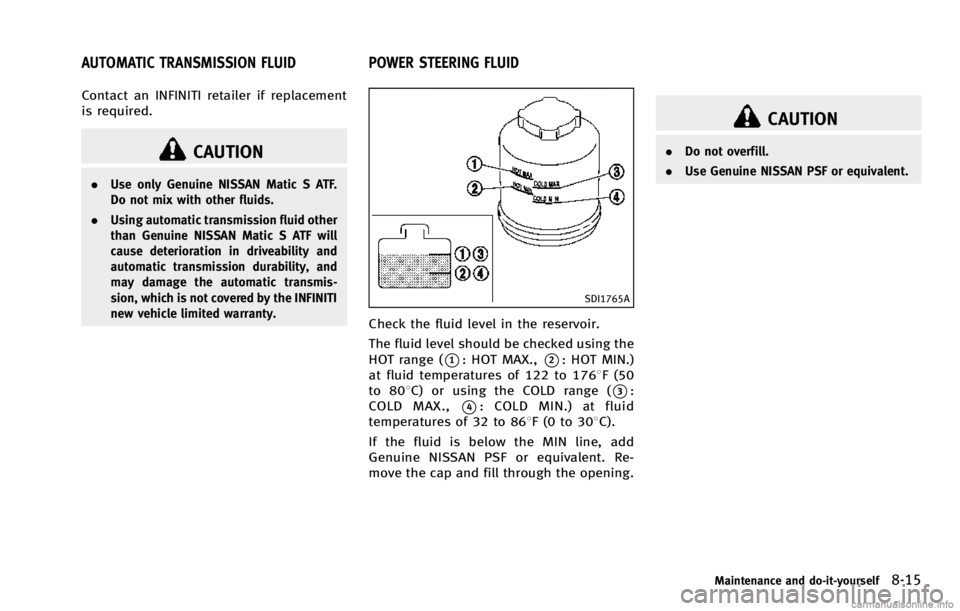
Contact an INFINITI retailer if replacement
is required.
CAUTION
.Use only Genuine NISSAN Matic S ATF.
Do not mix with other fluids.
. Using automatic transmission fluid other
than Genuine NISSAN Matic S ATF will
cause deterioration in driveability and
automatic transmission durability, and
may damage the automatic transmis-
sion, which is not covered by the INFINITI
new vehicle limited warranty.
SDI1765A
Check the fluid level in the reservoir.
The fluid level should be checked using the
HOT range (
*1: HOT MAX.,*2: HOT MIN.)
at fluid temperatures of 122 to 1768F (50
to 808C) or using the COLD range (
*3:
COLD MAX.,
*4: COLD MIN.) at fluid
temperatures of 32 to 868F(0to30 8C).
If the fluid is below the MIN line, add
Genuine NISSAN PSF or equivalent. Re-
move the cap and fill through the opening.
CAUTION
. Do not overfill.
. Use Genuine NISSAN PSF or equivalent.
Maintenance and do-it-yourself8-15
AUTOMATIC TRANSMISSION FLUID POWER STEERING FLUID
Page 489 of 530

9-2Technical and consumer information
The following are approximate capacities. The actual refill capacities may be a little different. When refilling, follow the procedure
instructed in the“8. Maintenance and do-it-yourself” section to determine the proper refill capacity.
Capacity (Approximate)
Recommended specifications
US measure Imp measure Liter
Fuel 23-3/4 gal19-3/4 gal 90 See“Fuel information” (P.9-4).
Engine oil*1
Drain and refill
With oil filter change VK50VE
6-1/2 qt
5-3/8 qt 6.1
.Genuine NISSAN engine oil or equivalent*2
. Engine oil with API Certification Mark*10
. Viscosity SAE 5W-30
VQ37VHR
5-1/8 qt
4-3/8 qt 4.9
Without oil filter change VK50VE
6-1/8 qt
5-1/8 qt 5.8
VQ37VHR 4-7/8 qt
4 qt4.6
Cooling system
With reservoir VK50VE
11-5/8 qt9-5/8 qt
11
Pre-diluted Genuine NISSAN Long Life Antifreeze/Coolant (blue) or equivalent
VQ37VHR
10 qt8-3/8 qt
9.5
VQ37VHR (models with towing
package for Canada) 10-5/8 qt
8-3/4 qt 10
Reservoir VK50VE
7/8 qt3/4 qt 0.8
VQ37VHR 7/8 qt3/4 qt 0.8
Automatic transmission fluid ———
Genuine NISSAN Matic S ATF*3
Front differential gear oil ———Genuine NISSAN Differential Oil Hypoid Super GL-5 80W-90 or API GL-5
Viscosity SAE 80W-90*4
Rear differential gear oil VQ37VHR without towing pack-
age
——— Genuine NISSAN Differential Oil Hypoid Super GL-5 80W-90 or API GL-5,
Viscosity SAE 80W-90*4
VK50VE/VQ37VHR with towing
package ———
API GL-5 synthetic gear oil, Viscosity SAE 75W-90*5
Transfer fluid ———Genuine NISSAN Matic J ATF*6
Power steering fluid (PSF) Refill to the proper oil level according to the instructions in the“8.
Maintenance and do-it-yourself” section. Genuine NISSAN PSF or equivalent*7
Brake fluid Genuine NISSAN Super Heavy Duty Brake Fluid*8 or equivalent DOT 3
Multi-purpose grease ———
NLGI No. 2 (Lithium soap base)
Air conditioning system refrigerant ———
HFC-134a (R-134a)*9
Air conditioning system lubricants ———NISSAN A/C System Oil
Type S or exact equivalent
Window washer fluid ———Genuine NISSAN Windshield Washer Concentrate Cleaner & Antifreeze or
equivalent
CAPACITIES AND RECOMMENDED FUEL/
LUBRICANTS
Page 490 of 530

*1:For additional information, see“Engine oil”(P.8-11) for changing engine oil.*2:INFINITI recommends Genuine NISSAN Ester Engine Oil available at INFINITI retailers.*3:Using automatic transmission fluid other than Genuine NISSAN Matic S ATF will cause deterioration in driveability and automatic transmission durability, and may damage the automatic
transmission, which is not covered by the INFINITI new vehicle limited warranty.
*4:For hot climates, viscosity SAE 90 is suitable for ambient temperatures above 328F(0 8C).*5:See an INFINITI retailer for service for synthetic oil.*6:Using transfer fluid other than Genuine NISSAN Matic J ATF will cause deterioration in driveability and transfer durability, and may damage the transfer, which is not covered by the INFINITI new
vehicle limited warranty.
*7:DEXRONTMVI type ATF may also be used.*8:Available in mainland U.S.A. through an INFINITI retailer.*9:For additional information, see“Vehicle identification”(P.9-11) for air conditioner specification label.*10:For additional information, see “Engine oil and oil filter recommendation ”(P.9-6).
Technical and consumer information9-3
Page 507 of 530
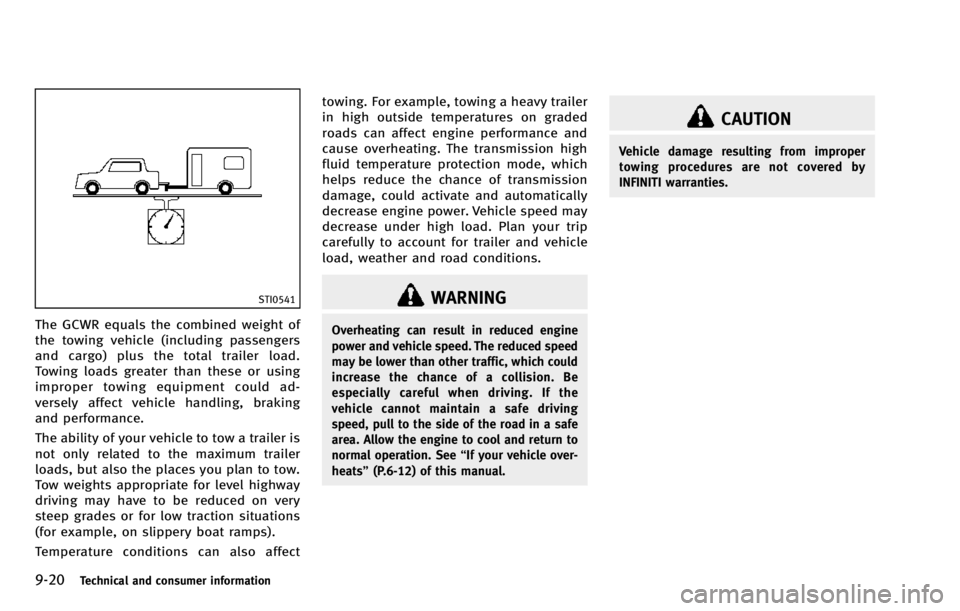
9-20Technical and consumer information
STI0541
The GCWR equals the combined weight of
the towing vehicle (including passengers
and cargo) plus the total trailer load.
Towing loads greater than these or using
improper towing equipment could ad-
versely affect vehicle handling, braking
and performance.
The ability of your vehicle to tow a trailer is
not only related to the maximum trailer
loads, but also the places you plan to tow.
Tow weights appropriate for level highway
driving may have to be reduced on very
steep grades or for low traction situations
(for example, on slippery boat ramps).
Temperature conditions can also affecttowing. For example, towing a heavy trailer
in high outside temperatures on graded
roads can affect engine performance and
cause overheating. The transmission high
fluid temperature protection mode, which
helps reduce the chance of transmission
damage, could activate and automatically
decrease engine power. Vehicle speed may
decrease under high load. Plan your trip
carefully to account for trailer and vehicle
load, weather and road conditions.
WARNING
Overheating can result in reduced engine
power and vehicle speed. The reduced speed
may be lower than other traffic, which could
increase the chance of a collision. Be
especially careful when driving. If the
vehicle cannot maintain a safe driving
speed, pull to the side of the road in a safe
area. Allow the engine to cool and return to
normal operation. See
“If your vehicle over-
heats” (P.6-12) of this manual.
CAUTION
Vehicle damage resulting from improper
towing procedures are not covered by
INFINITI warranties.
Page 514 of 530
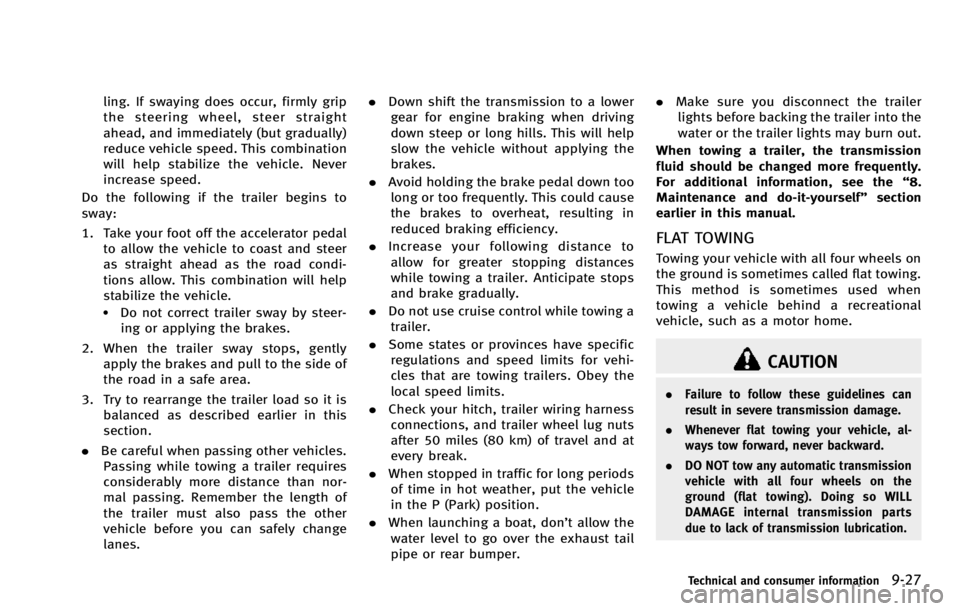
ling. If swaying does occur, firmly grip
the steering wheel, steer straight
ahead, and immediately (but gradually)
reduce vehicle speed. This combination
will help stabilize the vehicle. Never
increase speed.
Do the following if the trailer begins to
sway:
1. Take your foot off the accelerator pedal to allow the vehicle to coast and steer
as straight ahead as the road condi-
tions allow. This combination will help
stabilize the vehicle.
.Do not correct trailer sway by steer-ing or applying the brakes.
2. When the trailer sway stops, gently apply the brakes and pull to the side of
the road in a safe area.
3. Try to rearrange the trailer load so it is balanced as described earlier in this
section.
. Be careful when passing other vehicles.
Passing while towing a trailer requires
considerably more distance than nor-
mal passing. Remember the length of
the trailer must also pass the other
vehicle before you can safely change
lanes. .
Down shift the transmission to a lower
gear for engine braking when driving
down steep or long hills. This will help
slow the vehicle without applying the
brakes.
. Avoid holding the brake pedal down too
long or too frequently. This could cause
the brakes to overheat, resulting in
reduced braking efficiency.
. Increase your following distance to
allow for greater stopping distances
while towing a trailer. Anticipate stops
and brake gradually.
. Do not use cruise control while towing a
trailer.
. Some states or provinces have specific
regulations and speed limits for vehi-
cles that are towing trailers. Obey the
local speed limits.
. Check your hitch, trailer wiring harness
connections, and trailer wheel lug nuts
after 50 miles (80 km) of travel and at
every break.
. When stopped in traffic for long periods
of time in hot weather, put the vehicle
in the P (Park) position.
. When launching a boat, don’t allow the
water level to go over the exhaust tail
pipe or rear bumper. .
Make sure you disconnect the trailer
lights before backing the trailer into the
water or the trailer lights may burn out.
When towing a trailer, the transmission
fluid should be changed more frequently.
For additional information, see the “8.
Maintenance and do-it-yourself” section
earlier in this manual.
FLAT TOWING
Towing your vehicle with all four wheels on
the ground is sometimes called flat towing.
This method is sometimes used when
towing a vehicle behind a recreational
vehicle, such as a motor home.
CAUTION
. Failure to follow these guidelines can
result in severe transmission damage.
. Whenever flat towing your vehicle, al-
ways tow forward, never backward.
. DO NOT tow any automatic transmission
vehicle with all four wheels on the
ground (flat towing). Doing so WILL
DAMAGE internal transmission parts
due to lack of transmission lubrication.
Technical and consumer information9-27
Page 515 of 530

9-28Technical and consumer information
.DO NOT tow an All-Wheel Drive (AWD)
vehicle with any of the wheels on the
ground. Doing so may cause serious and
expensive damage to the powertrain.
. For emergency towing procedures refer
to“Towing recommended by INFINITI”
(P.6-14) of this manual.
Automatic transmission
All-Wheel Drive (AWD) models:
Do not tow an AWD vehicle with any of the
wheels on the ground.
Two-Wheel Drive (2WD) models:
To tow a vehicle equipped with an auto-
matic transmission, an appropriate vehicle
dolly MUST be placed under the towed
vehicle’s drive wheels. Alwaysfollow the
dolly manufacturer’ s recommendations
when using their product. DOT (Department Of Transportation) Qual-
ity Grades: All passenger car tires must
conform to federal safety requirements in
addition to these grades.
Quality grades can be found where applic-
able on the tire sidewall between tread
shoulder and maximum section width. For
example:
Treadwear 200 Traction AA Temperature ATREADWEAR
The treadwear grade is a comparative
rating based on the wear rate of the tire
when tested under controlled conditions
on a specified government test course. For
example, a tire graded 150 would wear one
and one-half (1 1/2) times as well on the
government course as a tire graded 100.
The relative performance of tires depends
upon actual conditions of their use, how-
ever, and may depart significantly from the
norm due to variations in driving habits,
service practices and differences in road
characteristics and climate.
TRACTION AA, A, B AND C
The traction grades, from highest to low-
est, are AA, A, B and C. Those grades
represent the tire’s ability to stop on wet
pavement as measured under controlled
conditions on specified government test
surfaces of asphalt and concrete. A tire
marked C may have poor traction perfor-
mance.
WARNING
The traction grade assigned to this tire is
based on straight-ahead braking traction
tests, and does not include acceleration,
cornering, hydroplaning, or peak traction
characteristics.
TEMPERATURE A, B AND C
The temperature grades A (the highest), B,
and C, representing the tire’s resistance to
the generation of heat and its ability to
dissipate heat when tested under con-
trolled conditions on a specified indoor
laboratory test wheel. Sustained high
temperature can cause the material of the
tire to degenerate and reduce tire life, and
excessive temperature can lead to sudden
UNIFORM TIRE QUALITY GRADING
Page 520 of 530
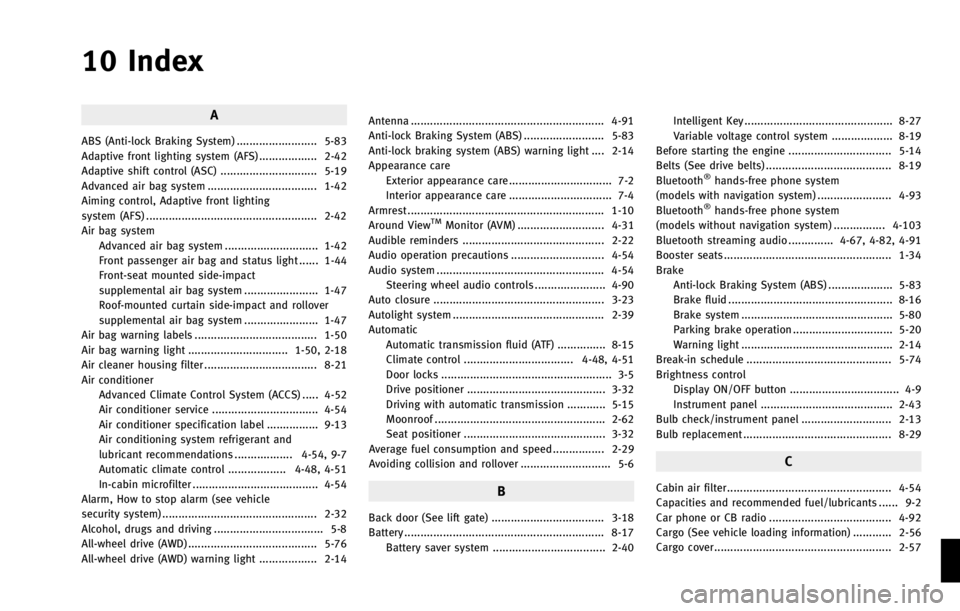
10 Index
A
ABS (Anti-lock Braking System) ......................... 5-83
Adaptive front lighting system (AFS) .................. 2-42
Adaptive shift control (ASC) .............................. 5-19
Advanced air bag system .................................. 1-42
Aiming control, Adaptive front lighting
system (AFS) ..................................................... 2-42
Air bag systemAdvanced air bag system ............................. 1-42
Front passenger air bag and status light ...... 1-44
Front-seat mounted side-impact
supplemental air bag system ....................... 1-47
Roof-mounted curtain side-impact and rollover
supplemental air bag system ....................... 1-47
Air bag warning labels ...................................... 1-50
Air bag warning light ............................... 1-50, 2-18
Air cleaner housing filter ................................... 8-21
Air conditioner Advanced Climate Control System (ACCS) ..... 4-52
Air conditioner service ................................. 4-54
Air conditioner specification label ................ 9-13
Air conditioning system refrigerant and
lubricant recommendations .................. 4-54, 9-7
Automatic climate control .................. 4-48, 4-51
In-cabin microfilter ....................................... 4-54
Alarm, How to stop alarm (see vehicle
security system) ................................................ 2-32
Alcohol, drugs and driving .................................. 5-8
All-wheel drive (AWD) ........................................ 5-76
All-wheel drive (AWD) warning light .................. 2-14 Antenna ............................................................ 4-91
Anti-lock Braking System (ABS) ......................... 5-83
Anti-lock braking system (ABS) warning light .... 2-14
Appearance care
Exterior appearance care ................................ 7-2
Interior appearance care ................................ 7-4
Armrest ............................................................. 1-10
Around View
TMMonitor (AVM) ........................... 4-31
Audible reminders ............................................ 2-22
Audio operation precautions ............................. 4-54
Audio system .................................................... 4-54 Steering wheel audio controls ...................... 4-90
Auto closure ..................................................... 3-23
Autolight system ............................................... 2-39
Automatic Automatic transmission fluid (ATF) ............... 8-15
Climate control .................................. 4-48, 4-51
Door locks ..................................................... 3-5
Drive positioner ........................................... 3-32
Driving with automatic transmission ............ 5-15
Moonroof ..................................................... 2-62
Seat positioner ............................................ 3-32
Average fuel consumption and speed ................ 2-29
Avoiding collision and rollover ............................ 5-6
B
Back door (See lift gate) ................................... 3-18
Battery .............................................................. 8-17
Battery saver system ................................... 2-40 Intelligent Key .............................................. 8-27
Variable voltage control system ................... 8-19
Before starting the engine ................................ 5-14
Belts (See drive belts) ....................................... 8-19
Bluetooth
®hands-free phone system
(models with navigation system) ....................... 4-93
Bluetooth
®hands-free phone system
(models without navigation system) ................ 4-103
Bluetooth streaming audio .............. 4-67, 4-82, 4-91
Booster seats .................................................... 1-34
Brake
Anti-lock Braking System (ABS) .................... 5-83
Brake fluid ................................................... 8-16
Brake system ............................................... 5-80
Parking brake operation ............................... 5-20
Warning light ............................................... 2-14
Break-in schedule ............................................. 5-74
Brightness control Display ON/OFF button .................................. 4-9
Instrument panel ......................................... 2-43
Bulb check/instrument panel ............................ 2-13
Bulb replacement .............................................. 8-29
C
Cabin air filter ................................................... 4-54
Capacities and recommended fuel/lubricants ...... 9-2
Car phone or CB radio ...................................... 4-92
Cargo (See vehicle loading information) ............ 2-56
Cargo cover....................................................... 2-57